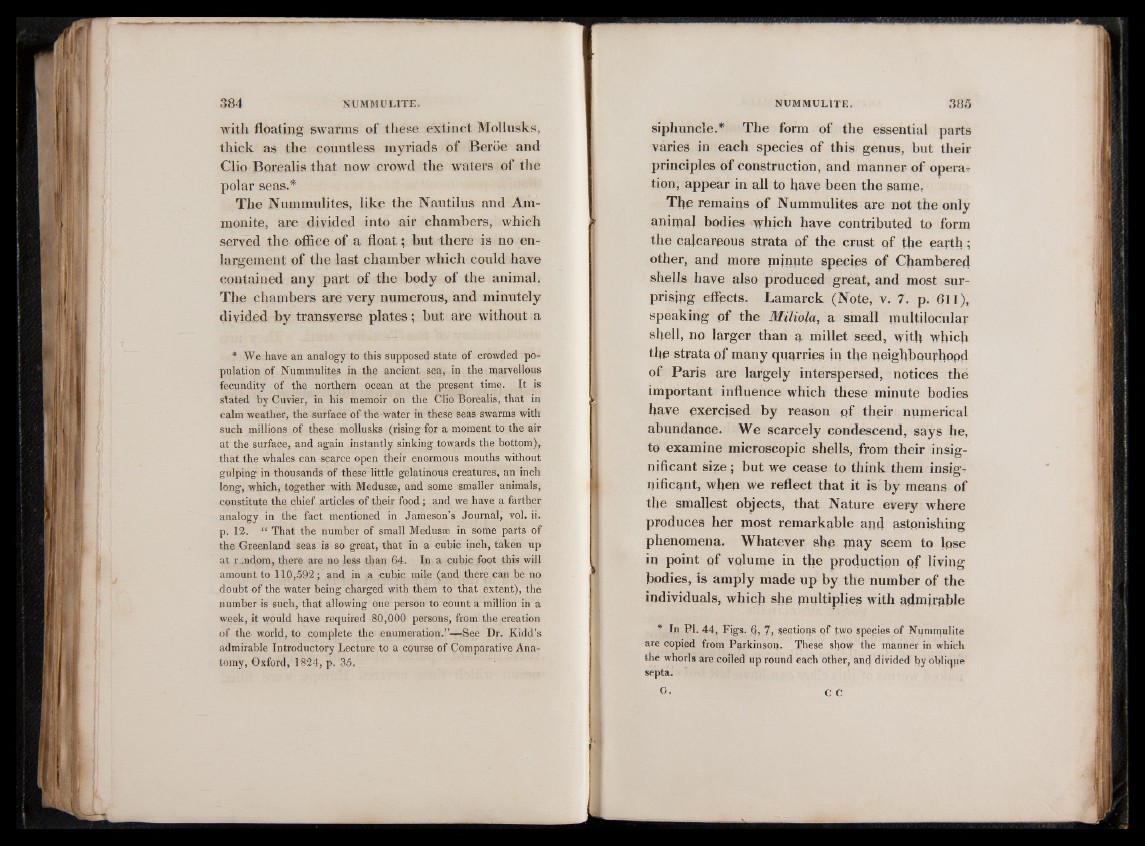
with floating swarms of these extinct Mollusks,
thick as the countless myriads of Beroe and
Clio Borealis that now crowd the waters of the
polar seas.*
The Nummulites, like the Nautilus and Ammonite,
are divided into air chambers, which
served the office of a float; but there is no enlargement
of the last chamber which could have
contained any part of the body of the animal.
The chambers are very numerous, and minutely
divided by transverse plates; but are without a
* We have an analogy to this supposed state of crowded population
of Nummulites in the ancient sea, in the marvellous
fecundity of the northern ocean at the present time. It is
stated by Cuvier, in his memoir on the Clio Borealis, that in
calm weather, the surface of the water in these seas swarms with
such millions of these mollusks (rising for a moment to the air
at the surface, and again instantly sinking towards the bottom),
that the whales can scarce open their enormous mouths without
gulping in thousands of these little gelatinous creatures, an inch
long, which, together with Medusa:, and some smaller animals,
constitute the chief articles of their food; and we have a farther
analogy in the fact mentioned in Jameson’s Journal, vol. ii.
p. 12. “ That the number of small Medusae in some parts of
the Greenland seas is so great, that in a cubic inch, taken up
at random, there are no less than 64. In a cubic foot this will
amount to 110,592; and in a cubic mile (and there can be no
doubt of the water being charged with them to that extent), the
number is such, that allowing one person to count a million in a
week, it would have required 80,000 persons, from the creation
of the- world, to complete the- enumeration.”—See Dr. Kidd’s
admirable Introductory Lecture to a course of Comparative Anatomy,
Oxford, 1824, p. 35.
wI
siphuncle.* The form of the essential parts
varies in each species of this genus, but their
principles of construction, and manner of operar
tion, appear in all to have been the same.
The remains of Nummulites are not the only
animal bodies which have contributed to form
the calcareous strata of the crust qf the earth;
other, and more minute species of Chambered
shells have also produced great, and most surprising
effects. Lamarck (Note, v. 7. p. 611),
speaking pf the Miliola, a small rnultiloculap
shell, no larger than a millet seed, with which
the strata of many quarries in the neighbourhood
of Paris are largely interspersed, notices the
important influence which these minute bodies
have exercised by reason pf their numerical
abundance. We scarcely condescend, says he,
to examine microscopic shells, from their insignificant
size; but we cease to think them insignificant,
when we reflect that it is by means of
the smallest objects, that Nature every where
produces her most remarkable and astonishing
phenomena. Whatever she moy seem to Ipse
in point of volume in the production of living
bodies, is amply made up by the number of the
individuals, which slip multiplies with admirable
* In PI. 44, Figs. Q, 7, sections of two species of Numrnulite
are copied from Parkinson. These show the manner in which
the whorls are coiled up round each other, and divided l}y oblique
septa.
G. C C